The Frank Brindley Collection
The Frank Brindley Collection
Ken Wragg contributed quite a few photographs that he had received from a deceased relative Frank Brindley who was a freelance news photographer who went out getting some great views in bad weather. The photos were taken mainly in the Sheffield area but Ken does not have any information to go with the shots.
So the following gallery is a little different in that it will be built piece by piece, a couple of shots will be posted and any information received regarding the vehicles and location posted. Then more shots will be posted and hopefully we will end up with a very interesting gallery. Here are the first couple of shots the location should be fairly easy the vehicle maybe a little trickier.
27/01/14
Ye Old Cross Scythes Hotel
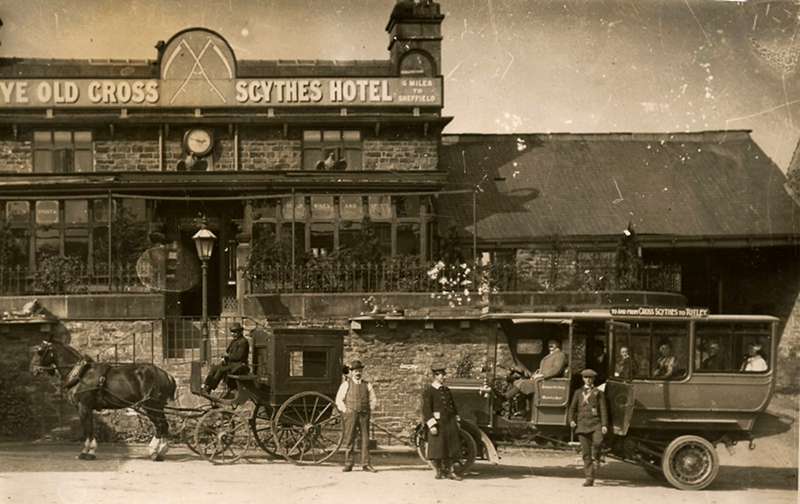
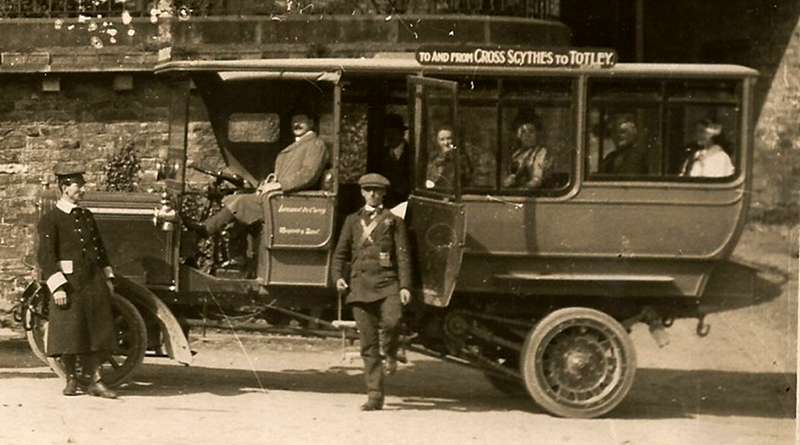
If you would like to add any information to the above please click here
27/01/14 - 17:57
Interesting route boards since the Cross Scythes is at Totley. For many years this was the terminus of the 45 Sheffield Pond Street to Totley service. Totley was one of those Derbyshire villages subsumed by Sheffield - and therefore served by the B fleet (for sometime the strong-hold of 1954 Regent III/Weymanns). In the early days of the omnibus - as indeed this must have been - there was an "interchange" at Millhouses Waggon & Horses with the trams. This may be one of those services. Equally interesting, the name Brindley. One of the country's greatest Victorian and Edwardian organ-builders was Brindley & Foster of Sheffield. Charles Brindley came originally from Baslow (Derbyshire) - no great distance from Totley. At one time, about half the area's organs were built by Brindley & Foster and most of the rest by Albert Keates - a one time apprentice to Brindley.
David Oldfield
28/01/14 - 06:55
Sheffield has two Cross Scythes hotels, this one is on Baslow Road, close to Totley. The bus journey would have been quite short I think. Dore & Totley railway station opened late in the 19th century so presumably this bus provided a link to the railway.
Les Dickinson
28/01/14 - 10:25
I used to go to the Cross Scythes, Derbyshire Lane, Norton Lees after choir rehearsal and Evensong each week in the early '70s. I cannot imagine the bus going down Scarsdale Road and Woodseats Road to achieve Abbeydale Road and then Totley. Did you have a second alternative Cross Scythes in mind?
David Oldfield
28/01/14 - 14:17
Hi David, The one in the pic is definitely the Baslow Road one and still looks pretty much the same now. I just think it a little strange to have a bus with route-boards for such a short journey? Hardly worth the effort of getting aboard the bus. The Derbyshire Lane one is the second but I don't think this bus would be linking two Cross Scythes, do you? Superb photo though.
Les Dickinson
28/01/14 - 14:52
That was what puzzled me, Les, about the short trip on the route boards. Any idea about the bus? It's chain driven - so very early. Is it a Shefflex or some other long gone locally manufactured vehicle?
David Oldfield
28/01/14 - 15:32
Page 125 of my bible aka 'Sheffield Transport by Chas C Hall' reads as follows "...but on 22nd May (1914) an advertisement of the Dart Motor Co. referred to the new service , stating that 'Our motor-bus service runs daily from Millhouses tram terminus to the Cross Scythes at Totley - Spend half a day in the pure moorland air. The bus runs from morning till night and the fare is only a few coppers'" Clearly the bus shown is not a Corporation bus, which carried livery from the first bus I believe? Sadly I know nothing of the Dart Motor Co.
Les Dickinson
28/01/14 - 15:53

Its not good at all I'm afraid Les
Peter
28/01/14 - 16:19
Your bible and mine Les. That's where I got my information about the Millhouses connection.
David Oldfield
29/01/14 - 06:27
Excellent news that a gallery of Frank Brindley's work is forthcoming.
The Cross Scythes frontage had been a terminus and turnaround point for buses from Sheffield to Totley for donkeys' years until 2009 following notice being given by Enterprise Inns that the agreement would not be renewed. After much deliberation a piece of council owned land about half a mile beyond Totley on the A621 was used to construct a new off road turning circle. Apparently resulting from this decision, the 30mph limit was extended to the new site together with street lighting. The site is clearly visible on Google Earth but not on the Street View which is dated prior to construction.
For those interested, a forum with comments at the time on the scheme is here at this link.
John Darwent
31/01/14 - 15:09
It is indeed the Cross Scythes pub. The bus was a feeder bus from the train station at Dore, a mile or so away, down the hill. I believe it was the landlord who owned it. It was taken over in 1914ish as a consequence of the war with a need to simplify things. Sheffield bought its first buses in 1913. There are many pictures in the books of Totley & Thereabouts, Totley Old Photographs or In Colour & the Totley Tunnel. They have them on sale in Tesco's so I will get the correct titles. There are pictures before them with horse drawn busses also.
Andy Fisher
06/02/14 - 14:56
Further information. The horse bus ran before 1913, the stables were behind the motor bus. It ended up as a car sales pitch with a not so good reputation. Mr Golightly a local garage proprietor started a bus route to the Millhouses tram terminus, at that time on the junction of Abbeydale Rd South & Archer Road, up to Totley & Cross Scythes. He had other buses. Sheffield Corporation took it over on the 7th of September 1914. It may have been an Armstrong Whitworth bus. With regards the destination boards on the side of the bus it was common in Sheffield to have these as did the early trams. Destination blinds were around. but were not necessary on a one route vehicle.
Andy Fisher
12/02/14 - 15:41
The landlord of the pub started running a horse bus, as early as 1880. It was in conjunction with the LMS. It would have been invaluable for the men who dug the Totley Tunnel which opened in 1897 I think. Many of the men & their families lived around the Cross Scythes. Like the buses & trams they had side destination boards & each separate route had vehicles painted in a different colour. It was taken over in 1914, extended to the tram terminus at Millhouses, which then was by the Archer Road junction, where the Robin Hood pub was. This was a starting point for 3 bus routes then. It would have been shortened again when the tram route was extended to Abbey Lane by the Dore & Totley Rail Station.
Andy Fisher
03/02/14
Two Buses in a Flood
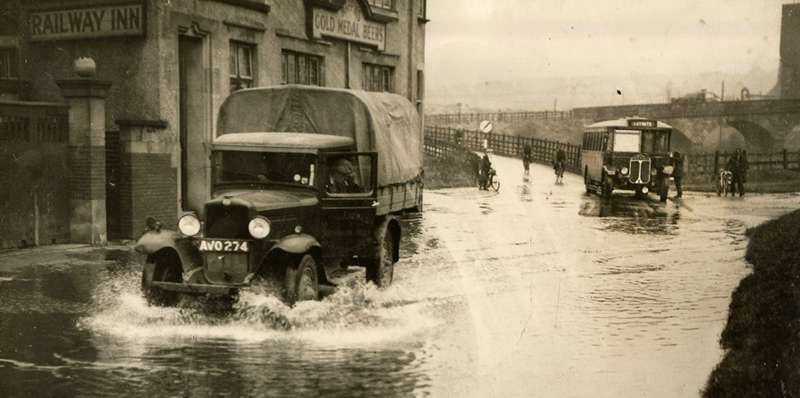
This first shot is captioned on the reverse of the photograph as 'Flood Near Swallownest'.
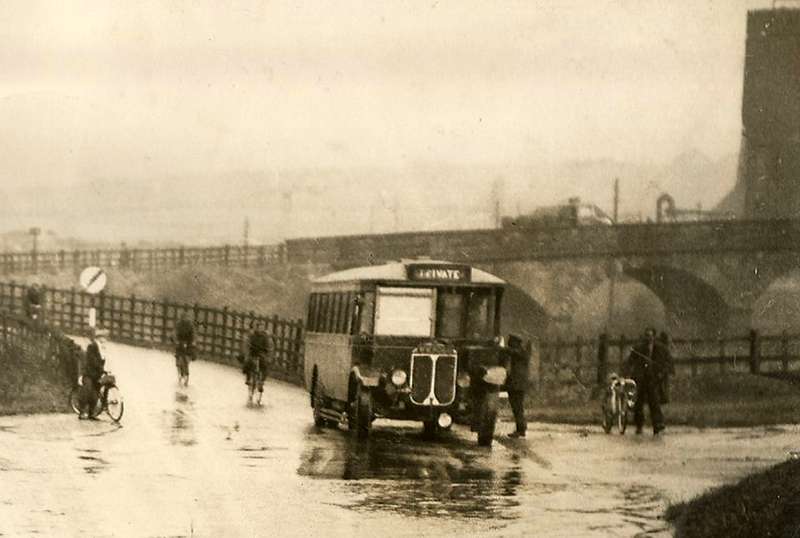
This is just a close up of the bus in the first shot.
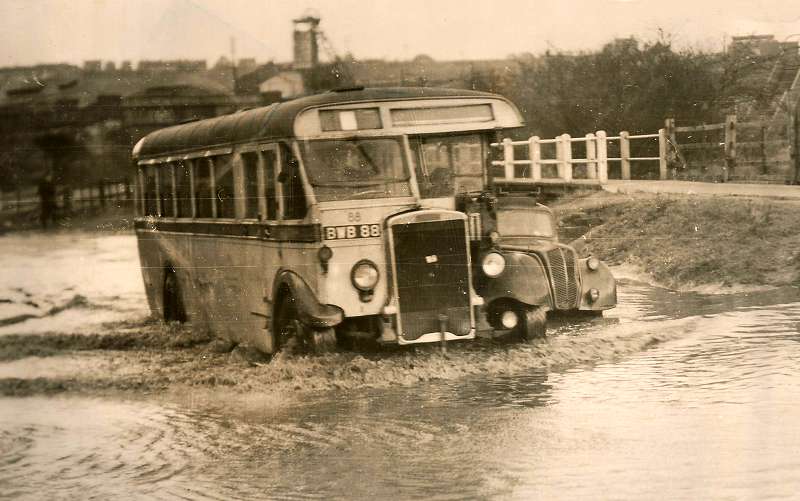
Registration BWB 88 fleet number 88. Nothing known and the lack of the destination blind doesn't help.
If you would like to add any information to the above please click here
03/02/14 - 14:02
Number 88 was one of a batch of three (87-89)delivered 1935 and were B32R Cravens-bodied Leyland TS7c.
Not sure of the location but is that a water-tower in the background? Several of Sheffield's hill-tops had a water-tower, but hill-top flooding would be unusual.
3 mins later
On further inspection, it is a pit-head, not a water-tower.
Long shot, could this be on the 99 at Ford? Although there was a ford, it sometimes flooded beyond the normal width of the recognised ford.
Les Dickinson
03/02/14 - 18:05
I don't know the area, but the raised footway, with railings on the right would suggest that it could well be a ford, with the alternative higher route for pedestrians.
Also, between the bus and the pit head, there looks to be a railway bridge. If that is at a lower level, there's a chance that the line could have been inundated too.
Petras409
04/02/14 - 07:43
What make of bus is in the first two photos? Superficially, it looks like an AEC but the rad is surely too short for that and not right at the bottom. Neither does it look like a Thornycroft.
Chris Hebbron
04/02/14 - 13:54
I wondered that too Chris. Is it a Vulcan?
John Whitaker
04/02/14 - 16:03
Chris and John, I'm puzzled by this vehicle, too. At first glance I thought it might be an SOS, but it clearly isn't on proper inspection. Pictures of Vulcan buses are as rare as hen's teeth, but photos of contemporary goods models show different radiator shapes. However, Vulcan was becoming decidedly desperate for orders in the 'thirties', and turned out all sorts of bespoke pieces of equipment, so it might be a Southport product. One other point intrigues me. Where is the registration plate? I think that what appears to be the maker's name over the top of the radiator is, in fact, the registration number. I wonder if the radiator has been embellished to meet an operator's idea of modernisation.
Roger Cox
04/02/14 - 18:00
Yes, I think the van is a Ford E93A
Roger Broughton
05/02/14 - 06:25
I wondered if the bus might have been a Morris Commercial Dictator, but comparing it to other photos of Dictators I doubt it.
While the radiator does have a hint of Thornycroft could it possibly be an AJS?
The van alongside the TS7c is a Morris "Z" type, based on the "E" series Morris 8 car. Many thousand's of the vans saw service with the GPO who were still taking them into stock as late as 1953 a good 5 years after car version was deleted.
I wonder if the van has stalled in the flood and the TS7 is rescuing the hapless driver?
Eric Bawden
05/02/14 - 06:26
The bus has completely baffled me but the van is surely a GPO Morris.
Tony Gallimore
05/02/14 - 09:27
I stand corrected, it is indeed a Morris Z in a ford.
Roger Broughton
05/02/14 - 11:58
Trying to identify this vehicle by the radiator might be something of a red herring. To an extent it resembles the radiator of an AJS Commodore, but only 'resembles'. It also looks very bright which suggests it may have been touched up, so the odd embellishment of the lower part may not be correct. In addition it seems to have something draped over the top of it which effectively disguises any sort of badge. Perhaps it could be a railway bus?
Mike Morton
This is the best I can do, I am a bit of a rookie with RT, having stared at the registration for quite a while it looks like WW 906 the last digit could be another 6.

Peter
05/02/14 - 15:44
Mike, I've looked at several pictures of the Commodore in period publicity material and the radiator seems to differ from bus to bus, although none are exactly like the one in the flood.
I wonder therefore if it could be an AJS Admiral.
I have not been able to find a shot of an Admiral anywhere, but as I believe there were only eight built before AJS went bust, and before any publicity material was published, that is hardly surprising.
Eric Bawden
05/02/14 - 15:46
This is indeed fascinating! I wonder if the caption on the photograph could be a little inaccurate, the only two railway lines which pass relatively close to Swallownest are the ex GC Sheffield to Retford and the Midland route from Chesterfield to Rotherham. The type of stone arch bridge suggests the latter and it appears that there could be more than two tracks which there were in the Treeton area. The Railway Inn selling Gold Medal Beers is probably long gone but nothing seems to resemble the location on Google satellite view.
The area was predominantly Sheffield Transport territory but the bus is not in their livery, other possibilities are East Midland but doesn't resemble anything in their fleet history and not in their livery either, Wigmore's of Dinnington or Booth and Fisher, the latter operated some Garner vehicles but they were small buses which I assume were normal control. I'm sure it's not a SOS because such vehicles of the period weren't true half cabs but had very narrow cabs which didn't extend over the radiator, I wouldn't expect to see a SOS in that part of the world either. I think the bus dates from around 1929/30 for which a WWxxxx registration would be appropriate. The radiator appears to be round topped and I think it's a valid point to say embellishments may have been added, I've never seen anything like it though. So three questions, location, vehicle and operator. I've looked through most of my stuff and found no clues, come along chaps, we musn't give up on this one!
Chris Barker
05/02/14 - 16:24
Can I see a WW reg mark as well Peter.
That smacks of a connection with the wonderful West Yorkshire RCC! not exclusively, of course.
Is it just possible that the "embellished" radiator is a Tilling Stevens B10 series, with the reg. plate over the header tank?
Otherwise, thats me beaten on this one!
The body does have something of a United/Tilling flavour about it.
John Whitaker
05/02/14 - 16:25
I think that the radiator grill is a homemade affair fixed to the front of the genuine radiator, which has a round topped top tank. Could it be an ADC or even an old Tilling Stevens.
An old Bristol B or a Leyland PLSC seem more likely Though.
Tony Gallimore
05/02/14 - 17:07
The bus shown in the top two pictures does indeed seem to be something of an enigma. At first glance Tilling-Stevens springs to mind, given the radiator shape, but somehow the front wings don't look right. The radiator does appear to have been embellished at some point, so maybe the front wings could have been 'upgraded' at the same time (maybe ex-Leyland or AEC?). The treatment of the area at the top of the windscreen is unusual, appearing to have a 'slit' of glass above the opening part, although the split windscreen proper does seem to open in the usual manner. Squinting the eyes a little, does the registration number begin with WW? West Yorkshire had quite a number of WW-registered vehicles delivered in 1928/29, namely Tilling-Stevens B10As with Tilling bodies, and Leyland Tiger TS1s with Roe bodies. Although West Yorkshire had a penchant for 'tin bible' destination displays at that time, a new owner could have replaced this with the blind display seen in the photographs, using parts from elsewhere. Whatever the vehicle is, I'm sure our dedicated team of super-sleuths will have the case cracked pretty soon.
Brendan Smith
05/02/14 - 17:09
Eric - I had the same problem with AJS pics. Just noticed that although I thought the photo may be touched up, that triangle at the bottom does seem to be reflected in the road (smaller image). A Maudsley ML was another thought but the radiators seemed to be pretty square pre-war, and if anything the actual outline shape is more like a Thornycroft. Tempted to say the ornamentation has been added later.
Chris - I also scanned that area on Google Street Map and could find nothing that resembled the Railway Inn. The nearest reference of that name was at Dronfield but the backdrop in the photo is too open. I suspect the biggest problem is that the entire landscape could have been bulldozed over and over, though the railway line betweem Woodhouse and Kiveton Bridge is possible as I doubt an industrial line would merit a 'Railway Inn'.
Mike Morton
06/02/14 - 06:23
I had a feeling that this is Orgreave in the background viewed from Treeton, but most of Orgreave has now been opencasted & vanished. That long artificial gradient on the railway bridge suggests somewhere flat which gave priority to railways & industry & folk had a long detour after the railway was built. Looks like railway company fencing, too.
Must try harder.
Joe
06/02/14 - 06:26
On the back of this photo it states:
Heavy rain causes flooding for miles in the Rother Valley nr Sheffield and down to Rotherham. Snapped today {not dated} of Sheffield main road
near Swallownest just before they closed it to traffic.
Close inspection of original photo shows number plate is ww 906? those wings do not match.
Ken Wragg
06/02/14 - 06:29
FWIW, the Bedford WHG truck in the foreground went into production in April 1931. Does its registration give any clues as to the whereabouts? Would enlarging the 'Gold Medal Ales' sign show the brewery name in the curved part of the board?
Chris Hebbron
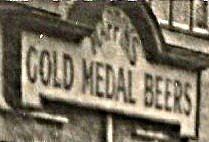
06/02/14 - 07:58
Any advance on Catcliffe? Mappins were a Rotherham Brewery who possibly had railway interests.
Joe
06/02/14 - 09:34
A very cursory glance at an old West Yorkshire fleet list reveals WW 9075/6 - but they were Tilling Stevens B10A2s with Tilling B31R bodies - the bus in the flood appears to be front entrance and so, although the registration number is certainly WW 906*, the identity of the vehicle is beyond me I'm afraid.
Chris Youhill
06/02/14 - 09:35
Catcliffe is possible but the road passes under the railway there. I think it is more likely to be the south side of Orgreave, where the much rebuilt Sheffield Road (B6200) towards Woodhouse Mill passes over the railway line. It is apparent that several bridges have been reconstructed or demolished along that stretch of railway so few old brick arches now remain. With regards to the bus, the livery seems to be dark and restrained - LMS? I think Doncaster has a connection with railway buses too.
Mike Morton
06/02/14 - 13:23
I googled "Vulcan Bus" and clicked Images. Flickr has an early-30s-looking photo of an Irish country town main street with a bonneted single-decker belonging to Nugent's and having the same rather protruding front hubs as our mystery vehicle, but again the radiator is different. A similar search for AJS buses revealed the same projecting front hubs, but again the radiator gave no firm clues. Perhaps both Vulcan and AJS bought in a proprietary front axle. All very tantalising, especially as anyone who remembers this bus even as a child must now be at least 87.
Ian Thompson
06/02/14 - 13:24
For what it's worth, I've checked the fleet records for Wigmore and Booth & Fisher and there's nothing similar with either company recorded by the PSV Circle. At least this narrows it down a bit more. If the vehicle is still unidentified by next Wednesday (when I make my fortnightly trip to the Archive at the Manchester museum) I'll take a look at the fleet histories of local coach operators for anything starting WW 906.
Neville Mercer
07/02/14 - 06:40
WW 9068 was a 1929 Maudsley ML3 with a Barton & Danson B32D body. new to Laycock, Barnoldswick, 31 then to BC&N 67, then to Grant & McAllin, 100 Manvers Road, Beighton by 1/37 to 3/39. most of the above is in PSVC PB9.
Not sure if its the same bus but Beighton is in the Sheffield area. Maybe a DIY rad!
Mike Davies
07/02/14 - 06:40
The location is Beighton, just south-west of where the present A57 crosses the railway line. See this link.
It is entitled "Flooding at Beighton, Crown Terrace, Rotherham Road, note old coke plant and pit" then adds "This bus, "Pit Paddy", was Skinner and Holfords and had solide tyres and ran from Beighton to Waleswood, and was the first to do so."
You can make out the Railway Inn on the left, then the arches of the railway bridge and the chimneys of the coking plant on the right. There is no date but I found a reference to serious flooding in May 1932 which fits well with our mystery picture. Perhaps our mystery bus was "Pit Paddy 2". The location is unrecognisable today!
Mike Morton
PS. Skinner and Holford were the owners of the Waleswood Colliery to the right of the photograph, and therefore not a bus operator.
08/02/14 - 07:58
Well the mystery is solved, almost! The bus in the picture may not be WW 9068 if it didn't reach Grant & McAllin until 1938 and the photograph relates to the floods of 1932.
With regard to the location, I suspected it was as reported by Mike M, because I looked at every railway bridge on streetview between Rotherham and Kiveton Park and Renishaw and that was the only one (on the Midland route) which bore the slightest resemblance in layout. It certainly has changed dramatically and what's astonishing is that there was a community there which has totally disappeared!
Chris Barker
08/02/14 - 09:14
Well it's been nagging me all the while, but Mike makes sense. My brother lives in Beighton (Sothal to be precise) and I pass this way on my way in from the Aston/M1 junction. Most of the land-marks on the photographs have been swept away, though.
David Oldfield
08/02/14 - 09:59
Mike Davies's suggestion of a Maudslay ML3 makes plenty of sense. FJ 6154, at present on loan to the West Country Historic Omnibus Trust, has that same very short radiator with the rounded top, but not doctored (as in our mystery pic) by the owner. One point, though: FJ 6154 and other ML3s illustrated on the web don't seem to have that projecting front hub.
Sad that the place and its community have vanished. One of the delights of OBP is that it's not just about buses.
Ian Thompson
08/02/14 - 11:21
Thanks everyone for the very informative detective work both on the bus and area. Does anybody know if the Sheffield 88 Tiger may be working a special or works service as it is not normal to run with blank blinds and I see at least one passenger on board
Ken Wragg
08/02/14 - 12:43
Fully agree it is incredible how the whole community has vanished including what was clearly a substantial pub and of course all of the colliery and coking works, now just an empty space from which can be seen clearly on Google maps. The floods in 1932 were in May but our photo feels more like the winter. Floods seem to have been frequent on that stretch of the road, possibly due to the old mill race that ran down to the Rother. The photos on the archives pages with the bus with 'solide tyres' (Leyland Lion?) were certainly at a different time so I am tempted to go with the Maudsley ML3 theory. The registration and owner being in Beighton are too much of a coincidence. It was probably a regular pit service vehicle.
Mike Morton
08/02/14 - 15:48
...but is that a projecting front hub? Or something behind the wheel? My diggings suggested that the Orgreave mining/coking area was opencasted on a large scale as "Waverley" and was/is now being redeveloped. Even the river was moved. Soon the "Battle of Orgreave" will be only a memory....
A miners' train service once ran from Sheffield Victoria to Orgreave, but was replaced by buses permanently in 1932 after floods washed away bridges (Wikipedia). (There you are?)
Joe
08/02/14 - 16:59
I moved away from Sheffield in 1976 and down south in 1981. I still have brothers and family in the area and visited both regularly and frequently when my parents were still alive. The road from Handsworth to Catcliffe via Orgreave changed completely - including a sharp left hand bend to avoid land that was fenced off but totally flattened. Like a ring road, it eventually returned to its original alignment at Catcliffe Village - having come close to a retail village and an exit from the Catcliffe Link (the dual carriageway from the M1 into the centre of Sheffield). This land was adjoining that mentioned by contributors near to Treeton (another much changed - commuter - village) and a little further out Woodhouse. Of course, the main A57 also underwent an even more radical change. Originally taking a direct route through Darnall, Handsworth and Woodhouse Mill (close to, but not the same as, Woodhouse) via Swallownest to Aston. When the catcliffe Link was opened, the A57 was diverted up this link to a point close to the old Handsworth road. It then took - and still takes - a totally new alignment, but single carriageway, between Stradbrooke and Richmond, Normanton Springs and Woodhouse to within a mile of Crystal Peaks. This is the Town Centre for the Mosborough Townships which brought new, private, housing to and combined former Derbyshire villages including Beighton. Before arriving at Crystal Peaks, the A57 does another dramatic left hander going between Woodhouse and Beighton and then on a low viaduct over the desolate flatlands (literally) mentioned already - including buildings and railway lines seemingly abandoned years ago. It finallt reaches the original A57 at Swallownest. A lot of, but not all, this land is in Rotherham - and was originally in the West Riding CC area. This is true of Catcliffe, Treeton and Swallownest. Beighton and the "Townships" were originally in Derbyshire. Logic therefore places the original Derbyshire CC and West Riding CC boarder along the stretch of A57 from Crystal Peaks junction to Swallownest.
David Oldfield
09/02/14 - 07:41
Are there any clues as to whether the photos were actually taken around the same time? In relation to the 'unidentified bus' photo, the speed derestriction sign in the background dates the photo to at least 1934, as according to various sources this was one of the standardised traffic signs introduced following the 1934 Road Traffic Act & Regulations.
Just looked through Noel Woodhall's Car Numbers book and found AVO (as carried by the lorry) was first issued by Nottinghamshire in July 1934.
Going on to the Sheffield 88 view, following some delving on the web it appears that the Morris Z-type van was produced from early 1940 until 1953. If the photo had been taken during wartime the bus and van would surely have had headlamp masks, with the bus also having white wing edges, so presumably a lack of same points to the picture being postwar. Is the plot thickening? (Cue Eastenders drum intro).
Brendan Smith
I hope the title has not thrown you Brendan, apart from a flood there is no connection between the two shots, there could be ten years between them for all I know.
09/02/14 - 07:46
To satisfy my (and possibly others) curiosity, could someone in the know post a Google Maps Street View of the area in question, if possible?
Chris Hebbron
09/02/14 - 09:28
88 was a Tiger TS7/Craven new in 1935, part of a batch of three withdrawn between 1948 and 1950. It looks a little manky but is not in war-time guise which would tend to indicate it was towards the end of its life. Along with the Morris van that would put the picture between 1945 and 1950 at the latest.88 was a Tiger TS7/Craven new in 1935, part of a batch of three withdrawn between 1948 and 1950. It looks a little manky but is not in war-time guise which would tend to indicate it was towards the end of its life. Along with the Morris van that would put the picture between 1945 and 1950 at the latest.
David Oldfield
09/02/14 - 12:04
Here is the Google map link
The location of the photograph with the Railway Inn is Rotherham Road between the A57 and where it crossed the River Rother towards Beighton. It was known as Beighton Bridge. Zoom in for a close up. Streetmap itself is not very useful as the road is now at a higher level and very little can be seen beyond the verges.
Here is another link to a picture of the location during floods
There are other views on the Picture Sheffield site but the only date given is vague, i.e. 1920-1939.
Mike Morton
09/02/14 - 12:31
A chance search for 'BWB 88' brought the following surprising result.
www.na3t.org/road/photo/Hu03518
Hart's of Coppull were an interesting operator whose stage service (Croston to Southport) was sold to Ribble in 1953, but contract work was persevered with for a few more years, and the haulage side of the business continued for another couple of decades. The present-day incarnation is that of a DAF dealer.
I've no idea whether or not Hart's operated BWB 88 in its ex-Sheffield condition, I suppose there's a fair chance that they did.
David Call
10/02/14 - 07:47
The photograph featuring the "Maudsley" cannot date from 1932 as The Bedford lorry has an AVO registration. This was series was issued by Nottingham City Council from July to November 1934. The photo would therefore date from the winter of 1934/5 at the earliest. Also the truck looks a little battered, which would seem to indicate a somewhat later date than 1934/5.
David Hick
10/02/14 - 07:48
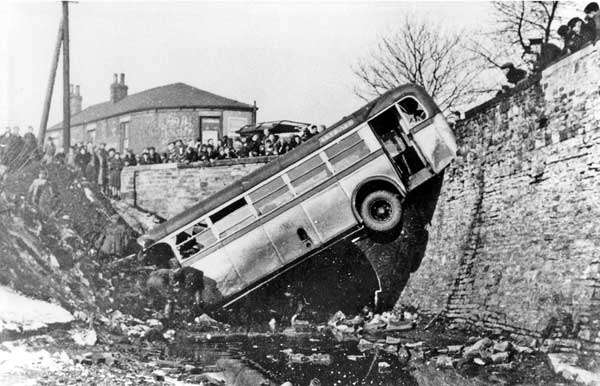
Just up the road from Beighton is Woodhouse Mill where another Sheffield saloon came to grief in 1947 in a watery environment.
John Darwent
10/02/14 - 18:17
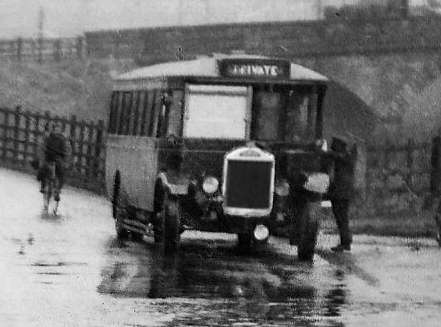
I concur with the reasoned idea that this is a Maudslay ML3. The Maudslay, like contemporary Albions, had the front axle positioned well forward under the bonnet, and this seems to be a characteristic of our mystery bus. As an experiment, I put a Maudslay radiator in place of its AEC cum SOS clone front end, and it fitted the aperture exactly.
Roger Cox
06/03/14 - 07:29
I can't help with the identity of the bus in the first picture, but the location is clearly the road from Beighton station to Swallownest, near where the road used to cross the River Rother and the railway lines, with the Beighton colliery (Brookhouse) in the background.
The Sheffield bus could be at more or less the same location - the 223 workmans service ran down that road from the pit, through Beighton and then Woodhouse to Sheffield.
John May
12/02/14
Single Deckers in the Snow
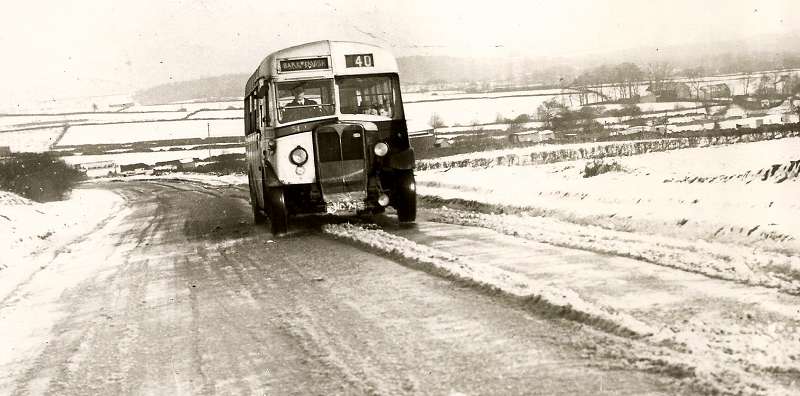
Info known - Sheffield 54 on route 40 to Bakewell via what looks like Sough.
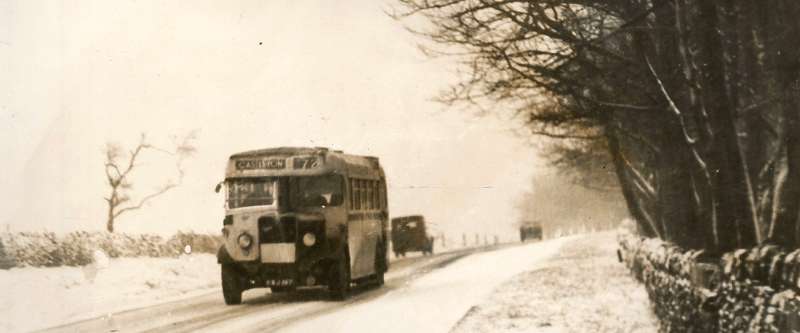
Info known - Sheffield on route 72 to Castleton a note says Stoneyridge Fox House.
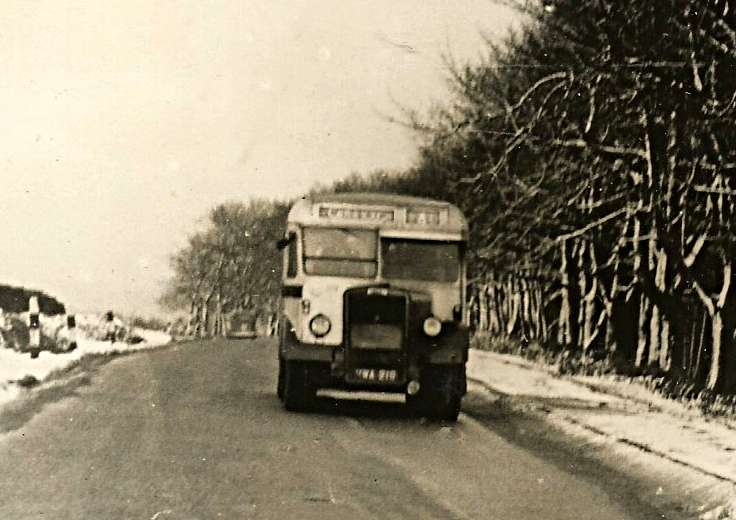
Not much known at all, looks like on route to a place with 8 letters and could start with the letter 'C'.
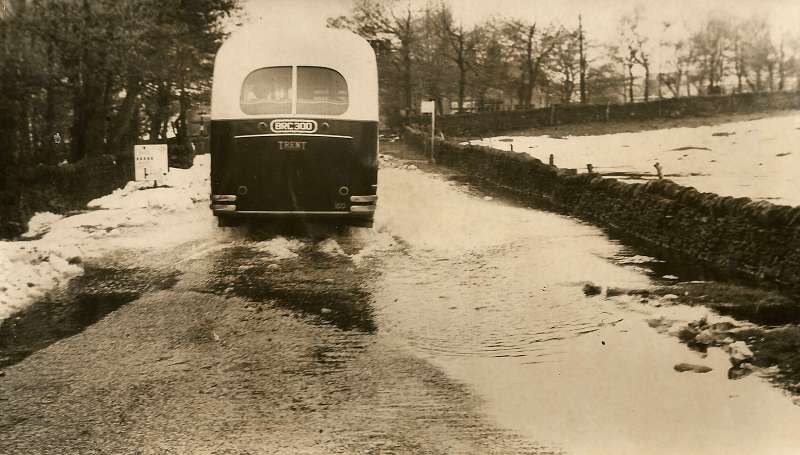
Info known - Trent 100 BRC 300 unable to read road sign on the left I'm afraid.
If you would like to add any information to the above please click here
12/02/14 - 08:56
Sough will presumably be Calver Sough?
Joe
12/02/14 - 09:23
(i) 54: LMC 745 (Regal/Weymann 1940 - ex demonstrator?) is on the 40, Sheffield to Bakewell via Carver Sough.
(ii) Possibly 197: KWJ 197 (Regal 1/Weymann 1948) on the 72, Sheffield to Castleton is probably on the approach to Fox House Inn from Sheffield. Fox House is, and always was, in the City of Sheffield (right on the extreme border with Derbyshire. (All the countryside along the road down into Dore and the city is within the city boundary.) You turn right at Fox House and go down the hill to a left hand bend at the "Toad's Mouth" (a rock formation). Just beyond here do you cross the county boundary into Derbyshire.
(iii) Possibly 218: KWA 281 (PS1/Weymann 1948). Very unclear but I would guess another 40, but a short working, to Calver.
(iv) Unable to help with the Trent. I suppose the location is the same area. If it were, and was in service rather than excursion or private hire, it would be an 84. It could be on its way to Sheffield, about to turn right - cutting the corner off Fox House which would be straight on.
David Oldfield
12/02/14 - 13:33
David, In respect of the Trent bus, I'm inclined to think that it is actually approaching the junction for Sheffield at Fox House itself. I think that the pub is hidden by the trees. I think that the bus stop visible on the other side of the road is the one that Chesterfield buses used at Fox House. For all my boyhood hiking in that area (sixties mostly) I know that North Western operated jointly with SJOC but don't recall ever seeing Trent on services. Perhaps it was different when these pictures were taken. The junction that you refer to, I'm sure had a sign with the road shown at 2o'clock rather than 3 o'clock as in this picture. It is a long time ago - I could be wrong!
Picture 3, as David says, is unclear. I suggest that this may be another 72 to Castleton. On the three-track route number indicator, I think first track shows 7 and third track shows 2. Middle track may have suffered the not uncommon overwinding leaving it unuseable until the next trip to Queen's Road? I think there are too many letters there for Calver.
Les Dickinson
12/02/14 - 13:36
Pic 1,Looks like the Bakewell side of Hassop Bar.
Pic 3,Destination is Castleton, heading towards Fox House from the direction of Dore.
Pic 4, The Trent saloon is approaching Fox House from the direction of Dore.
Roger Broughton
12/02/14 - 13:38
David, are you sure about the Trent route no.84? If so, was there a general route re-numbering? During the 1950s all route numbers from 60 to 84 were Nottingham area - the 84 being Nottingham to Sutton in Ashfield. I do recall that some of the 80s were renumbered (83 Nottingham - East Kirkby became 61B; 87 Nottingham - Arnold via Netherfield and Gedling became 67; 88 Nottingham - Stoke Bardolph became 68) but I am certain the 84 remained 84. In fact I don't remember any ordinary Trent routes reaching Sheffield, though I am open to correction.
Stephen Ford
12/02/14 - 13:40
I know little or nothing of the area, but could the PS1 in the third picture possibly be showing "CANKLOW" - there seems to be a "K" in there, just a thought.
Chris Youhill
12/02/14 - 15:05
In theory it could be showing Canklow, Chris, but he'd be in trouble if it did as we all know that Canklow is in Rotherham - in the opposite direction.
I am, of course, talking absolute rubbish. Trent only ever came into the equation when they took Buxton and Matlock from North Western in the '70s. The major players - other than SJOC - were North Western and then Potteries/first. You are right about Fox House lurking in the trees and the right angled junction - the other indeed being at two o'clock. The beauty of this forum is that I pontificate and others shoot me down - but we eventually get to the truth. Thanks chaps!
David Oldfield
12/02/14 - 15:06
I would suggest that all three of the Sheffield bus pictures are taken on Hathersage Road between the Dore Moor Inn and Stoney Ridge Road on the way to Fox House. No. 54 appears to me to be just round the then very tight bend (where Sheephill Road leaves for Ringinglow) having just passed the Clarion Clubhouse which was just before the bend. There is another Sheffield saloon just entering the bend behind 54. The other two pictures look to be further on the same stretch of road nearer to Fox House. I am uncertain about the Trent picture but would go with Les D's suggestion that it is approaching Fox House from the Owler Bar direction.
John Darwent
16/02/14 - 09:18
Picture 1 the destination is in a sloping style Bakewell via on top line /Calver Sough on bottom line.
Picture 3 close inspection the destination is Calver Sough on route 40
Ken Wragg
21/02/14 - 08:40
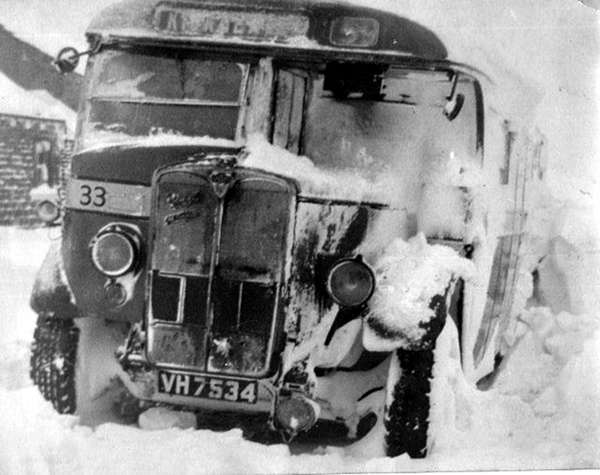
AEC Regal 33 VH 7534 was one of three Huddersfield Corporation single-deckers stranded for several weeks on this stretch of Ashes Lane, Castle Hill, Huddersfield during the long, hard winter of 1947. Ironically, the last bus to be stuck had been fitted with a snowplough to try and rescue the other two! (Copyright Arthur Shaw, but licensed for re-use).
Chris Hebbron
13/02/14
Double Deckers in the Snow
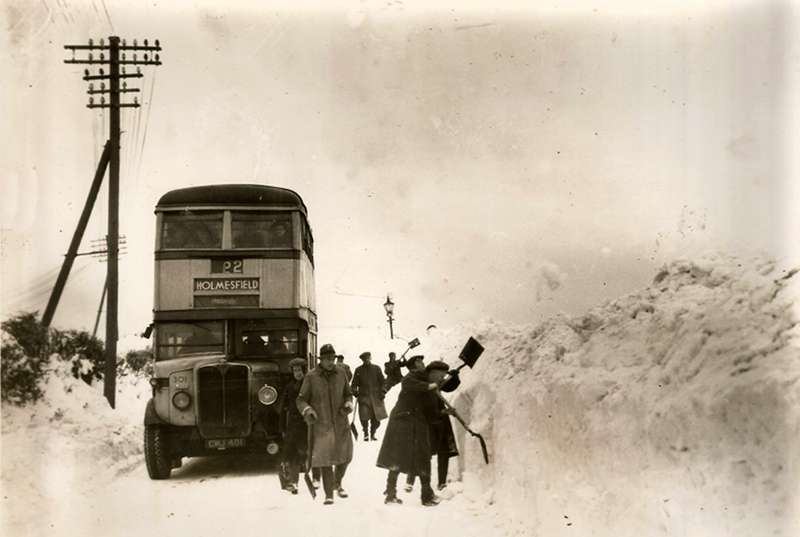
Info known - Sheffield 301 CWJ 401 on route 22 to Holmesfield.
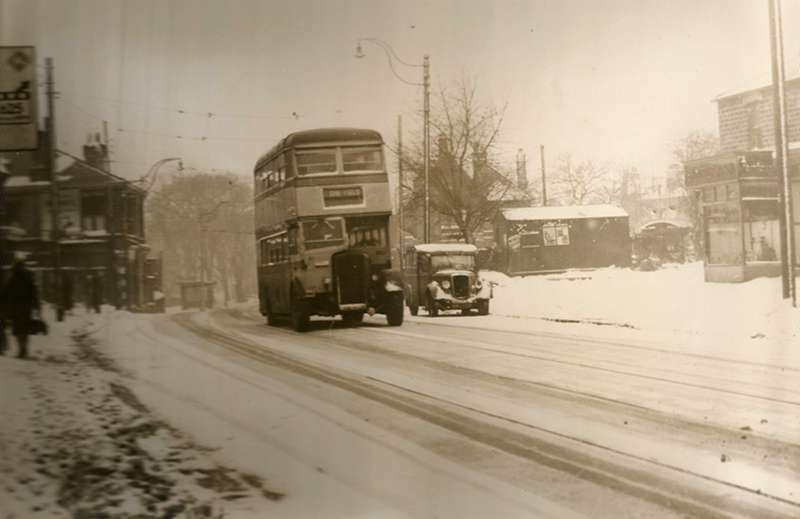
Info known - Sheffield 83 on route Sheffield the road sign on the left hand side of the shot shows the A625 bearing right.
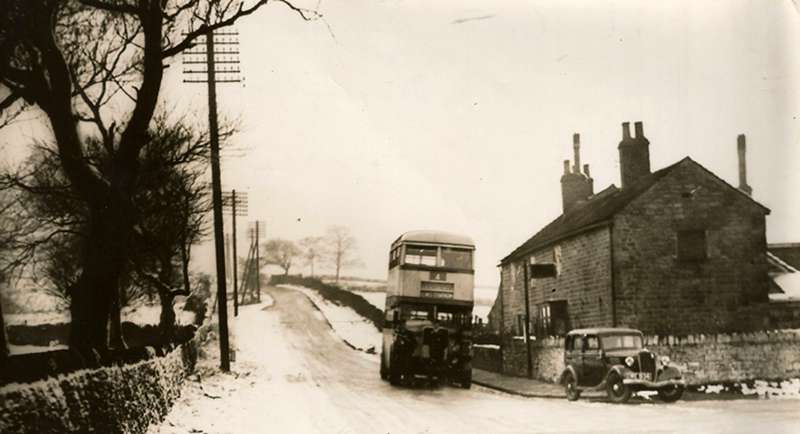
Info known - Sheffield stationary bus at Ringinglow on route 4 in November 1937.
If you would like to add any information to the above please click here
13/02/14 - 17:49
The picture of Daimler 83 is at Millhouses - the sign to the A625 is directing traffic up Whirlowdale Road to join the A625 at Whirlow. The tram shelter is alongside Millhouses Park just after Archer Road on the left. Springfield Road up to Ecclesall was on the right just past the shops and behind the hut.
John Darwent
13/02/14 - 17:52
The photo of Sheffield 83 is taken on Abbeydale Road at the Archer Road/Springfield Road junction. It must be on a return working from Totley or Bakewell via Baslow. The tram shelter in the background is most distinctive. The A625 signed to the right would be the route up Whirlowdale Road which joined the A625 proper at Whirlow Bridge.
83 (HWB 383) was a B fleet Daimler CWA6 with Duple H30/26R body new in 1945, sold 1955 to Harper Bros, Heath Hayes fleet no 9.
Ian Wild
14/02/14 - 06:56
The picture of the Regent at Ringinglow bearing route number 4 is interesting. The Sheffield Corporation Tramways and Motors map of June 1927 in C C Hall's book shows the Bents Green service as route 28 and no service to Ringinglow which must have been started since that date. From the late 40's, when I first took notice, the Ringinglow service was route 27 and by 1960 was still the 27 whilst the Bents Green route had by then become the 4 with a destination of Firth Park. So it is somewhat of a mystery why Ringinglow was originally route 4 unless it was shown in error. Can anyone throw any light on this?
John Darwent
14/02/14 - 06:57
The A66 between Scotch Corner and Penrith crosses Stainmore, a section that is particularly prone to closure in bad weather. When I left bus work and went onto HGV's, the café on Staimore Summit was a frequent watering hole of mine, around the walls were photos of several severe winters past, at first glance, one photo in particular appears to be that of someone standing next to a low wall in a snow covered field, when you read the inscription underneath, it turns out that its actually the roof of a bus, with only about a foot of it visible. The Truck stop at Tebay on the M6 has similar photos taken on the old A6 over Shap.
Ronnie Hoye
14/02/14 - 08:50
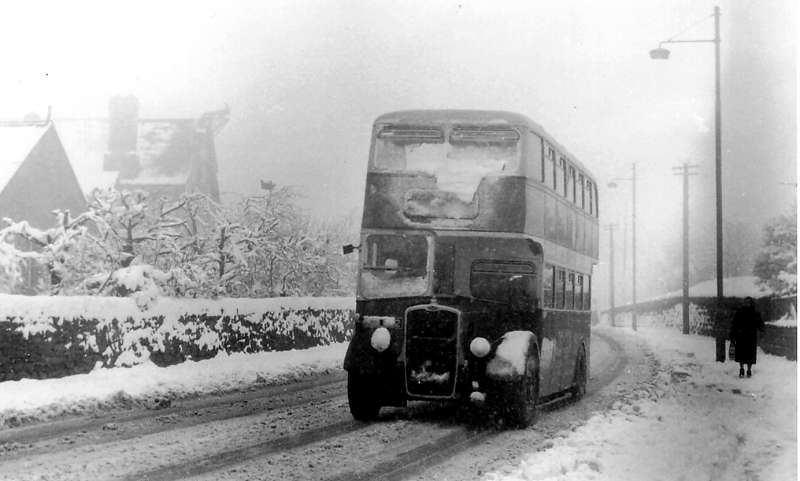
Samuel Ledgard Yeadon depot Bristol K6A/ECW L28/27R KHU 602 battling on as always in wicked Winter conditions on a journey from Otley to Horsforth via Yeadon. The routes (two variations) had always incurred excessive duplication when single deck operated because of a dubious bridge in Henshaw Lane Yeadon - until lowbridge double deckers were bought instead.
KHU 602 was one of three identical ex Bristol examples - well I say identical, but sister KHU 603 was one of the first Bristol AVW engined ones to "slip past" the policy of not selling on the ones so powered at the time.
The bus is virtually passing the access road to the Yeadon depot (The Moorfield - a previous proprietor's name bought out by Ledgard in 1934, and it stuck to the end).
Chris Youhill
14/02/14 - 13:35
During my student years at Sheffield (1965-8) service 4 was Firth Park - City - Bents Green, with occasional extensions to Ringinglow.
Interestingly the 1953 Sheffield timetable states that dogs may be carried only on Joint Omnibus Committee routes, but there were two Corporation routes where dogs were allowed - to Ringinglow and Rivelin Dams, both partly rural in character.
Geoff Kerr
ps I should have added that in 1953, Ringinglow was 27 and Bents Green 28. So yes the pre-war photograph of service 4 is a puzzle.
14/02/14 - 14:16
My memory was only of extensions to the 4 but research tells me that the 27 was indeed the regular Ringinglow service - to the Round House. I would have said that Ringinglow and Rivelin Dams were both very rural - you have to travel urban and suburban to get there! I was brought up in the Greenhill/Bradway area and knew the 22 very well - and also remember these conditions in 1962. I could only place this near Dronfield Woodhouse - but wherever it is, it has changed before what I knew in the '50s and '60s.
David Oldfield
15/02/14 - 17:24
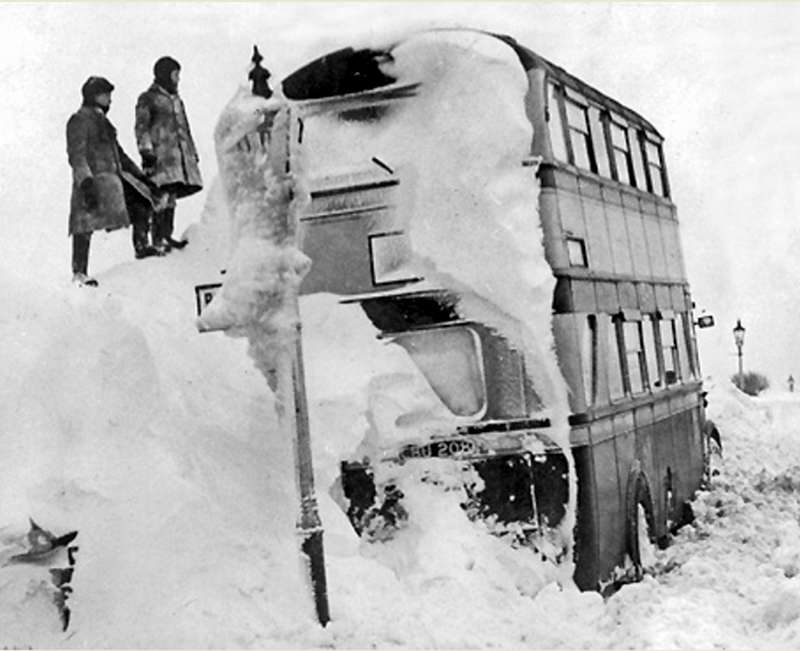
Continuing the theme of Double Deckers stuck in the snow the above picture is of Oldham Corporation Passenger Transport Department Leyland TD5, CBU 208, well and truly stuck in a snow drift.
The location is probably somewhere in Saddleworth in the bad winter of 1947.
Saddleworth, at that time in the West Riding of Yorkshire, was served by Oldham, and Manchester Corporations, along with the SHMD Board, and North Western Road Car Co Ltd.
Hanson's of Huddersfield also operated a Huddersfield to Oldham service via Uppermill and like all cross Pennine services was subject to severe disruption in the winter, this service using the Standedge cutting on the A62.
The area was notorious for large snow drifts.
CBU 208 was new in 1940, and had a Roe H31/25R body, and was withdrawn in 1958.
Stephen Howarth
16/02/14 - 07:47
And there is this Provincial bus in trouble at Gosport, too! See: www.old-bus-photos.co.uk/?p=4806
Chris Hebbron
16/02/14 - 09:15
The double deck at Ringinlow on route no 4 (pic 3) appears to have to top blind off its top roller, whilst the bottom blind shows LMS station
Ken Wragg
17/02/14 - 07:56
Chris, thanks for posting the photograph of KHU 602: it is passing the end of Ackworth Drive, where I now live - the gable end of the smaller building on the left is number 2 Ackworth Drive. The larger building behind number 2 was "The Peacock", a typical 1930s "roadhouse", now demolished and replaced by flats (mostly occupied by aircrew based at the nearby Leeds-Bradford airport). The telegraph poles have gone, as have the lamp-posts (replaced by modern versions - soon to be turned off from midnight to 6am), and the severely-pruned trees bordering number 2 were recently replaced by a laurel hedge. Above the wall on the right you will now see the roof-tops of bungalows on the small housing development that has replaced the Moorfield depot. First Leeds (Wright Gemini) and Yorkshire Tiger (Scania Omnithingy [as successors to Centrebus]) have now replaced Ledgard and WYRCC along this stretch of road.
Philip Rushworth
17/02/14 - 11:01
Philip - I'm so pleased that you are able to compare the picture of KHU 602 with the present day. In my roaring younger days I lived in Ilkley and Burley and was a frequent Saturday night reveller at the Peacock. I live in Headingley now and am a more demure regular diner at Murgatroyd's superb fish restaurant, last night for example !! When the Peacock was demolished I viewed one of the new flats under construction but it was far too small - and if I remember rightly serious subsidence caused one of the gable walls to have to be shored up with a large "buttress" while the problem was remedied. Ah well, back to the snow topic.
Chris Youhill
17/02/14 - 19:09
May I just say how much I am enjoying this particular gallery of photographs - especially the buses in the snow. I can't resist looking at them again and again - so atmospheric and evocative. I can make no useful comments about the vehicles or locations as it an area I am unfamiliar with, but thanks for posting them, and I do hope there are many more like them in the pipeline.
John Stringer
21/02/14 - 06:50
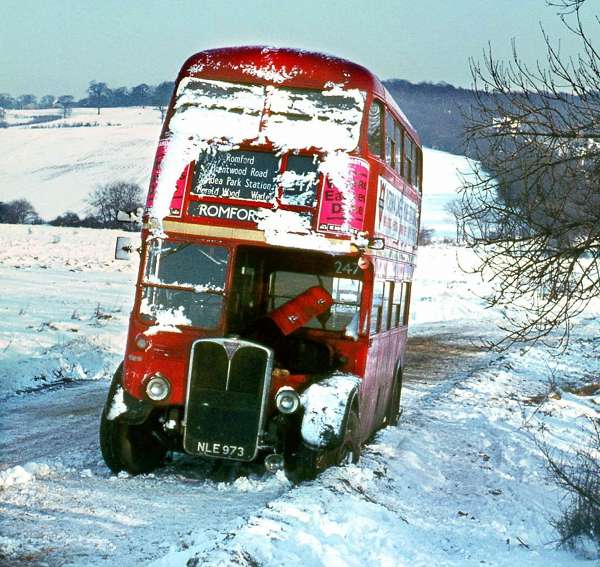
Another Double Decker stuck in the snow is London Transport RT - NLE 973, on the 247 to Romford.
Just goes to show that they do get snow in the LT area.
Stephen Howarth
21/02/14 - 12:07
This is RT4309, somewhere between Brentwood and Romford which is quite hilly countryside.
I had an aunt who lived at Harold Wood and was surprised to see red buses so far out. Maybe it was because, when lost in snow, the red stood out more than the green! One wonders how passengers and crew were rescued. The 247's destination in Brentwood was very much in keeping with LGOC's 'pub' tradition: BRENTWOOD - ROBIN HOOD & LITTLE JOHN.
Chris Hebbron
18/02/14
Two Works Buses and Buses Parked Up
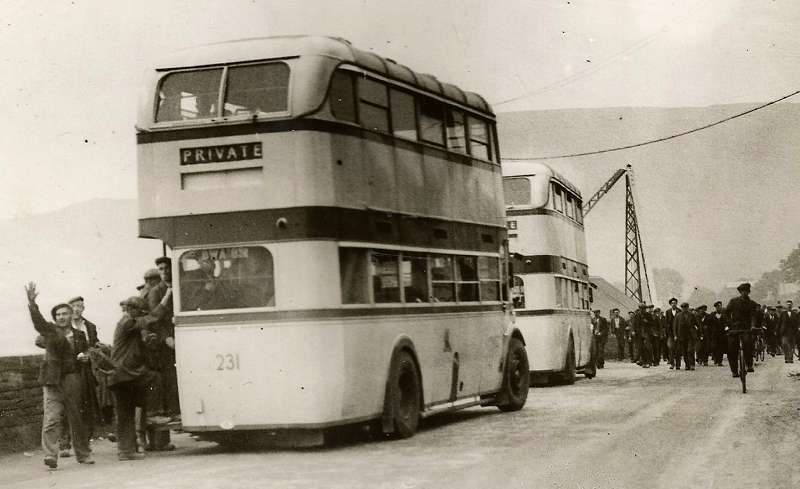
Info known - Registration BWA ??? fleet number 231.
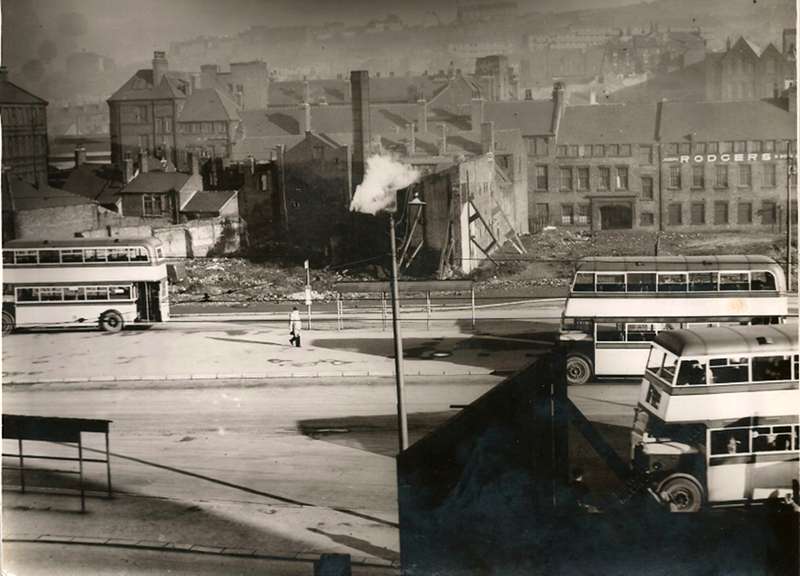
Buses parked up at a bus station somewhere, the name on the factory on the right as can be seen quite clearly is 'Rodgers'.
If you would like to add any information to the above please click here
18/02/14 - 15:58
The bus station is Sheffield's Pond Street.
231 is BWA 831, Weymann-bodied AEC Regent new in 1935, withdrawn between 1947-49 seating H56R
Les Dickinson
18/02/14 - 16:24
Goodness knows where 231 and friend are parked but the second photo is almost certainly an early post-war shot of part of Pond Street Bus Station, Sheffield. Beyond the buses is what became the Bus Park - beyond the platforms - and the sole bus on the left is roughly where Sheffield United Tours would build their post-war Pond Street Booking Office. Buses would drive along a road in front of Rodgers to get to the bus park. All of this was redeveloped in the '50s when the New Bus Station was built - which has been re-developed twice since - and the factories gave way to a swimming pool before nearby Pond's Forge was built for the World Student Games.
David Oldfield
19/02/14 - 08:26
The first photo could have been taken in the Derwent Valley whilst the Ladybower reservour was under construction going by the background.
Roger Broughton
19/02/14 - 10:55
I would think Roger B's pretty much on the money with the Ladybower location from the lie of the land. Interesting that there is only one rear light of any kind on the rear of 231 - looks like a rear light only but could have had a dual function possibly or were stop lights unheard of in the late 1930's?
John Darwent
19/02/14 - 11:25
John, Single rear lights either to the offside or centre mounted were quite legal until April 1955 when two were then required.
Roger Broughton
19/02/14 - 15:19
I think you will find it is a pit. Sheffield had loads in the surrounding areas. The "mountains" in the background would have been slagheaps. In front of the bus you can see a workshop.
I have a better picture in the Sheffield Memories book. I can confirm that it is the Rotherham Rd. at Beighton. All the clues match up. There are many railway lines in the area to transport the coal from the pits, as well as main line routes. It is also in a low valley, which the river Rother passes, it is now a wetland, so must have flooded regularly.
Andy Fisher
19/02/14 - 16:16
Andy
Nay, Lad that's na pit.
The crane nearby is the sort you would find moving stone etc, not coal.
That would be an enormous slag heap, too. Miners would have a snap tin, water bottle and helmet. Can't see any? And there's live trees!
Presumably Sheffield Corporation Waterworks would use their own buses to transport men to this remote spot. I think whoever suggested it done good.
Joe
19/02/14 - 17:36
I smiled to myself when John and Roger made comment regarding rear lights thinking of the modern Double Deckers with "Blackpool Illuminations" all over their rears! How ever did these vehicles of my schooldays get away with such singular and ineffective lighting?
Nigel Edwards
23/02/14 - 15:28
Yes Joe you are right. I meant to put the information on the bus in a flood posting.
Andy Fisher
Sorry to use Andy as an example here but this is what happens when you do not give me a clue as to where you want your comment to go because you did not fill in the 'Subject' box, chances are I will not guess correctly every time.
24/02/14
Outings
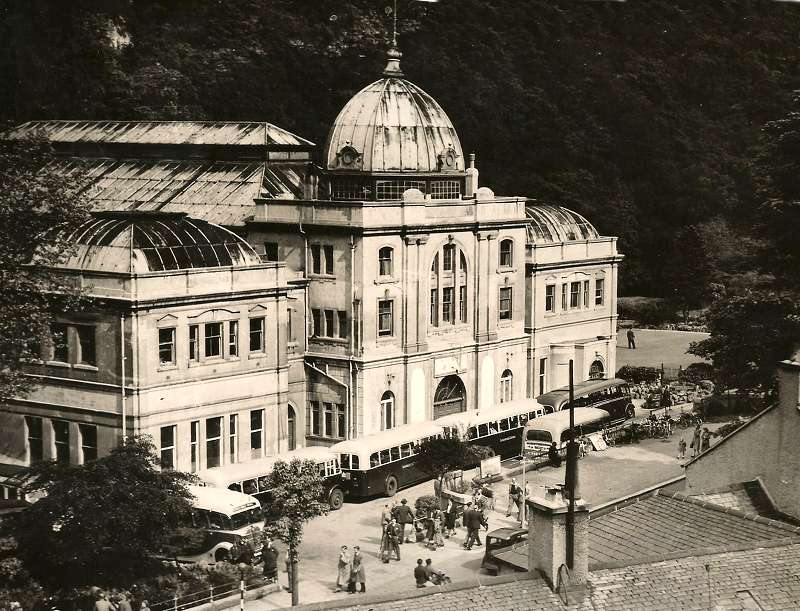
Coaches at Matlock Derbyshire
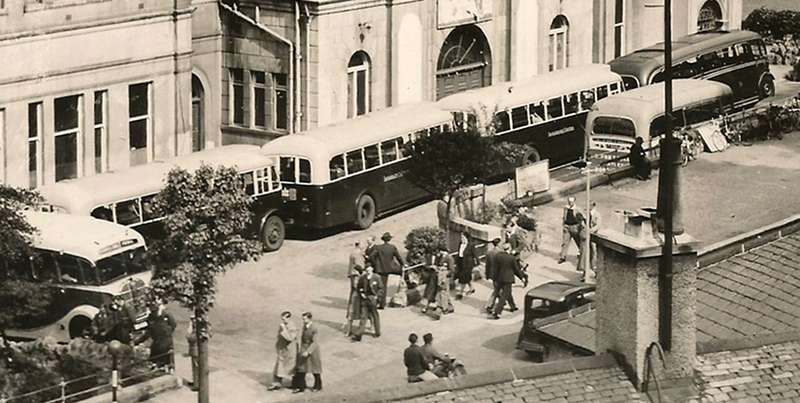
Closer shot of just the coaches at Matlock
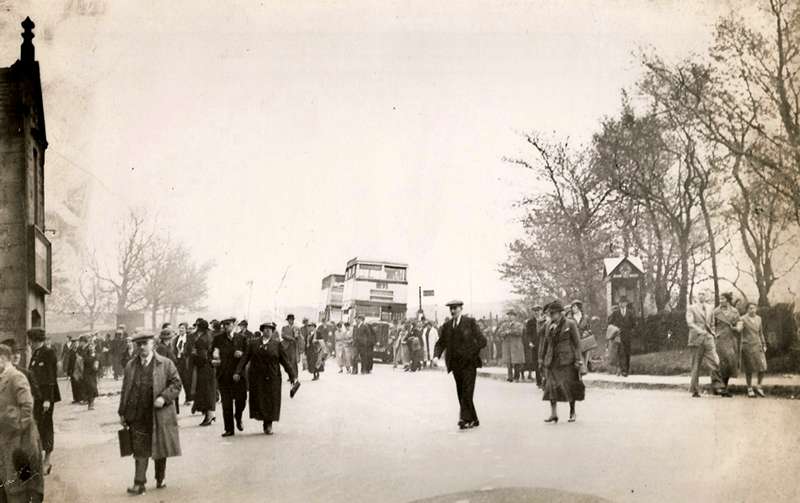
Sheffield crowds getting off buses at Fox House
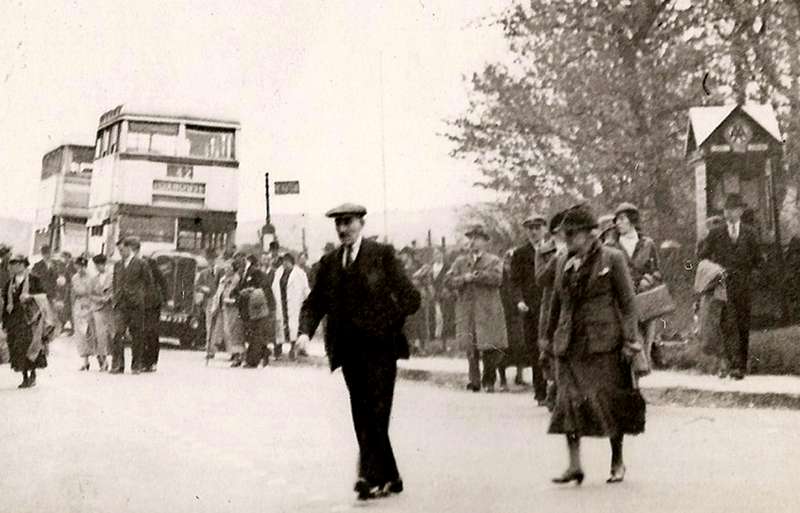
Close up of the buses at Fox House
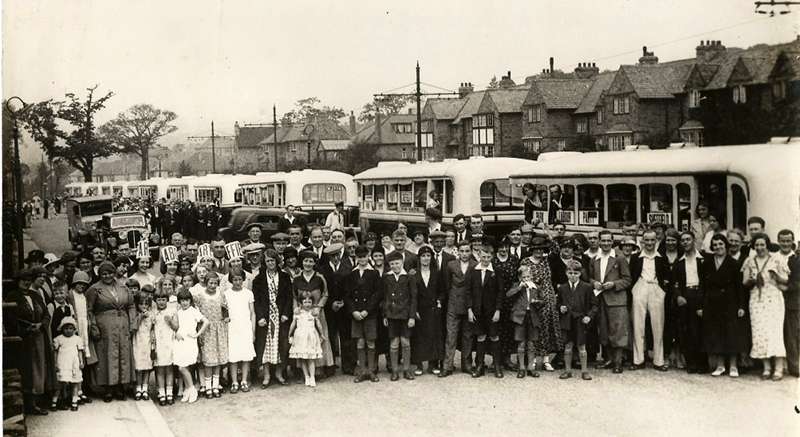
Labour Party outing Sheffield
If you would like to add any information to the above please click here
24/02/14 - 15:10
The coach neatly tucked into the left-hand corner looks like an Austin K8 with the distinctive radiator. I imagine the K8 reference was used, although the coaches were usually longer and lower than the van on which it was based and I've never seen any other reference given.
Chris Hebbron
24/02/14 - 17:25
As I've said before, Fox House is way out in the countryside near the Sheffield/Derbyshire border by the Longshaw Estate. In over sixty years of post-war life I have never seen half as many people at Fox House - even on a Bank Holiday. It shows how things have changed in less than a hundred years. Cars, not buses; a totally different style of clothing - only the Tax man or a rep for the brewery would be seen thus dressed at the Fox House these days. My parents met through hiking and Fox House was a bit of rural bus interchange before the term was coined. [You could go out on one bus, have your walk and return by a different route - and Chesterfield buses met Sheffield here, as they also did at Owler Bar.]
David Oldfield
25/02/14 - 07:01
More super pictures. The first images are of Matlock Bath Grand Pavilion, still going strong I believe.
The Regent/Weymann disgorging at Fox House may well be Sheffield No. 37, BWJ 737, a 1936 bus and a Leyland TD behind in the old Sheffield livery.
The political outing from Abbey Lane consists of a number of Sheffield saloons but the only one I can readily identify is the third from the camera which is either 143 or 144, 1933 Leyland TS6/Cravens B32R WJ 7743 or 7744, petrol engined buses which later became engineering buses living on 1956 and 1961 respectively.
John Darwent
25/02/14 - 07:01
Chris, it's larger than the K8. Probably the Austin CXD which would likely seat around 32 or 33 passengers.
Eric Bawden
25/02/14 - 09:21
What a fabulous selection of period views from what were arguably much happier days in general. The Sheffield saloons brought back childhood memories for me - not of Sheffield itself which I knew not at the time - of frequent holidays with relations in Bridlington and the wonderful local operator "Williamson's". Among their varied and always fascinating fleet was an ex Sheffield saloon, very like those in the Labour outing picture, but slightly earlier, WJ 521 - its rear entrance, unusual for Williamson's, always appealed to me for some reason.
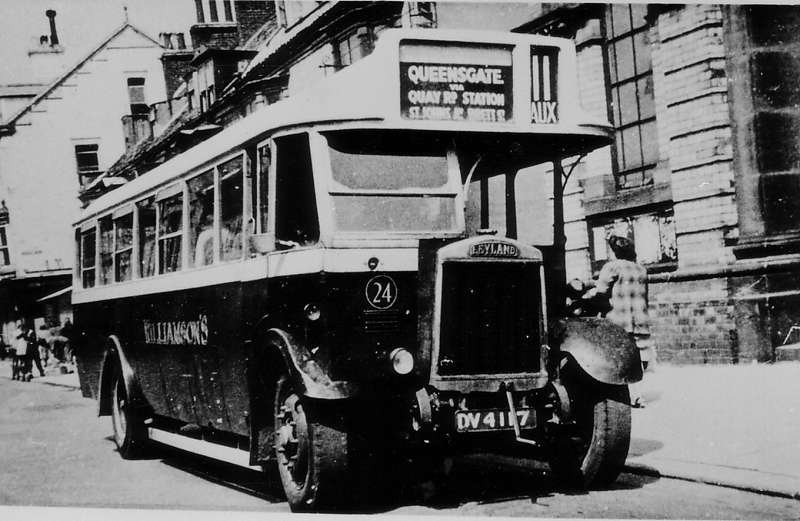
Mind you, it was outclassed by ex Devon General DV 4117 with front and rear doorways !!
Chris Youhill
26/02/14 - 07:50
Thx, Eric, for mentioning the classification of the Austin CXD coach. I wasn't aware of it, although I was of the CXB which was roughly the equivalent of the Bedford OB.
Chris Hebbron
26/02/14 - 12:17
Thanks to Chris Y for showing his "superior" machine, the ex-Devon General Leyland Lion. Presumably it had two doors in order to deal with the two queues - Q for Queensgate and Q for Quay Rd Station. Oh dear, it's a sad life thinking up awful funnies like this. . .
Michael Hampton
27/02/14 - 07:36
You need seriously bringing into line, Michael, for comments like that!
Chris Hebbron
23/06/14 - 08:13
Can anyone put a date to the 'Coaches at Matlock Derbyshire' picture. I suspect that suitably knowledgeable bus experts could give an approximate date from the types of vehicles in the photograph.
Steve Thompson
23/06/14 - 11:13
From the vehicles. I would date the first/second as being from around 1947 to mid 1950's.
I would date photos 3/4 to be the late 1930's, based mainly on their dress. I notice that the second bus is old enough to have a piano front, which might not have survived long post-war. Interesting bus stop might well help the experts. The AA box is no clue, because one like this survived only about five miles from my abode until about ten years ago!
I'd date the last photo to the late thirties, based on their dress. I notice there are tram poles etc in the background.
Just my two penn'orth!
Chris Hebbron
24/06/14 - 07:42
As Chris H has suggested in an earlier comment, the vehicle tucked away in the left hand corner of the first/second picture is an Austin CXD, which was about 25 feet long and usually bodied as a 30 seat bus or a 26 seat coach. It was available on the domestic market with an Austin 4 litre petrol or Perkins P6 diesel engine from 1948 to 1954, but remained available for export with the added option of the BMC 5.1 litre diesel until the late 1950s. The picture of the Royal Pavilion thus dates from 1948 or slightly later. Despite its somewhat Regency character, the Royal Pavilion at Matlock was built in 1910-12.
Roger Cox
21/04/15 - 07:03

This photo has been passed on from a contact with some other Frank Brindley photos to do with the Peak District. As I cannot identify it I pass it on to the OBP experts it is at Lovers Leap at Stoney Middleton.
Ken Wragg
04/06/15 - 09:34
Can anyone identify the last photo a (Commer?} at Stoney Middleton its seems to have been missed by SCT experts.
Ken Wragg
28/02/14
Two Single Deckers
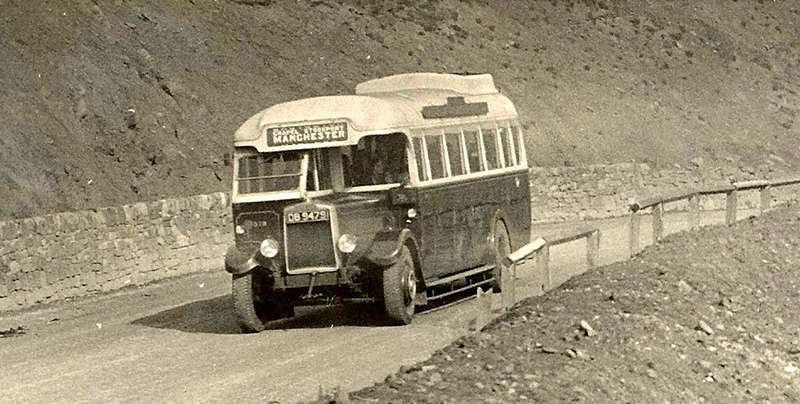
North Western DB 9479 Manchester bus on Mam Tor
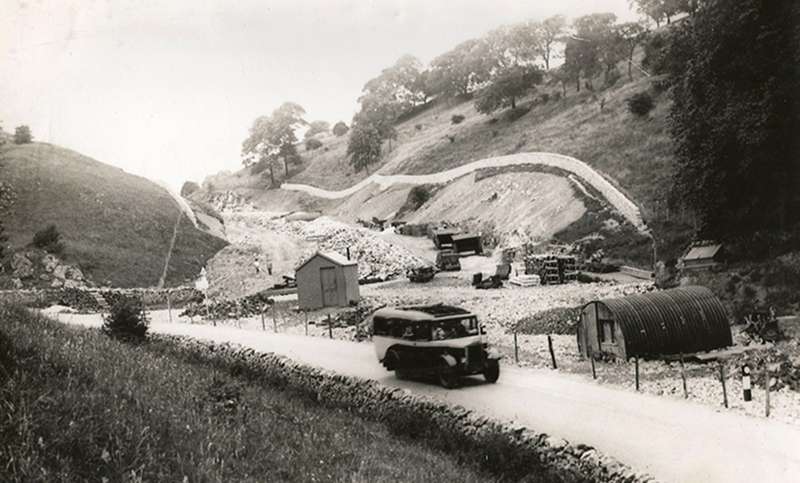
Photograph titled 'Old Bus Peak'
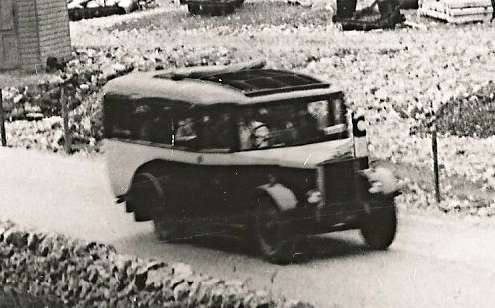
Close up of 'Old Bus Peak'
If you would like to add any information to the above please click here
01/03/14 - 07:13
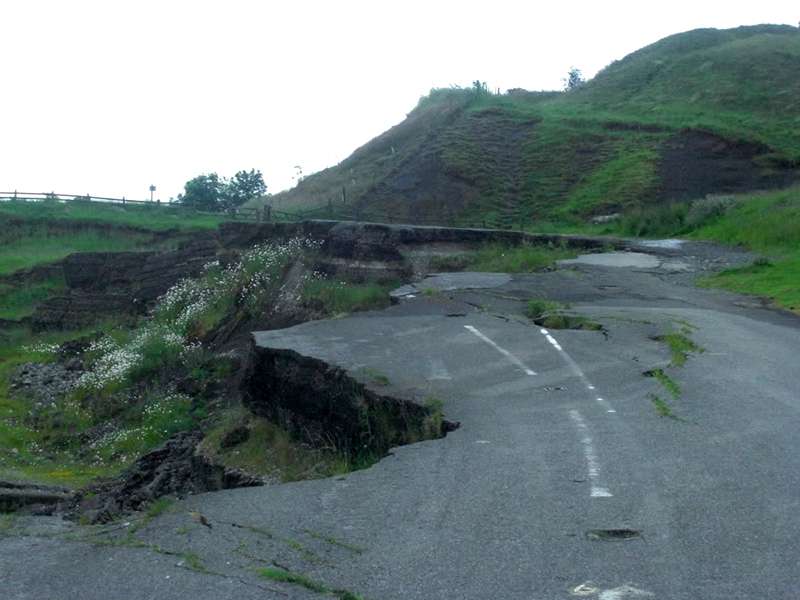
Should North Western DB 9479 to Manchester on Mam Tor (The Shivering Mountain) attempt the same route today, this is what it would find. The section of road (A625) was abandoned in 1979 when it became so unstable it was impossible to maintain. The Winnats Pass was improved to maintain a road link within the area but buses and vehicles over 7.5 tons are banned and use other routes.
John Darwent
01/03/14 - 13:40
The second Peak District photo could have been taken near the Blue John mine at top of Mam Tor on the A625.
Roger Broughton
04/06/14 - 08:13
I believe this photo was taken during the construction of the Taddington By-Pass, looking north towards Buxton. Can't identify the bus....yet, I'll need to strain the grey matter.
Andrew Critchlow
18/08/14 - 14:32
The second photograph ('Old Bus Peak') shows the east end of the Taddington Bypass under construction. The bus is on the old road where it swung out of the top of Taddington Dale to run south-westwards into the village. The road was part of the Ashford to Buxton Turnpike built 1810-1812 which later became part of the A6 running from London to Carlisle.
Taddington village had always presented serious problems with its narrow street, tight bends and steep gradients and a bypass was approved by the Minister in August 1936, said to be one of several (six?) known as the Edward VIII bypasses in commemoration of the new king.
The new road was built 80ft. wide with two carriageways of 20ft. and the photograph shows the construction of a cutting at its eastern end. Local memory is that the bypass was under construction in 1937, which indicates the date of the photograph, although the final completion was not until 1939.
Ray Slack
21/08/14 - 11:23
Had a further look in my files and you probably have all this info., but if not, this may be of interest.
Given a 1936/7 date for the early work on the bypass, the bus shown is likely to be on the service running between Buxton and Matlock which began in 1921, according to the recollections of a former resident of Taddington, although there is no reference to such a service in the 1922 Kelly's Directory.
My earliest record of the service is from the 1925 directory, when it passed through the village six times daily, as was again the case in 1928. By 1936 the frequency had increased to eleven times daily and in 1941 it was 'several times daily'.
Ray Slack
03/03/14
The Last Three
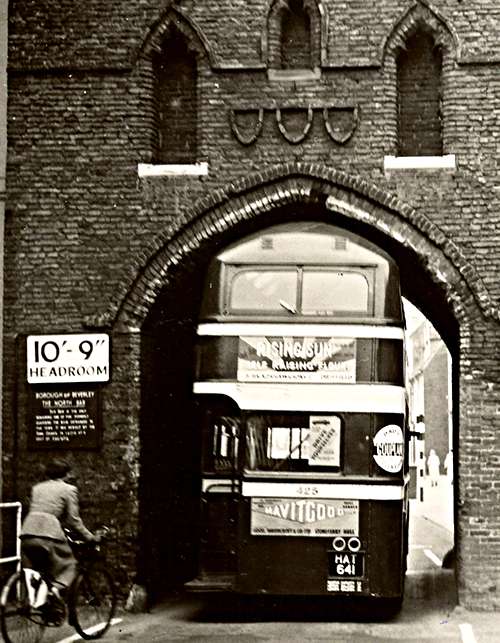
Good picture of that famous arch at Beverly
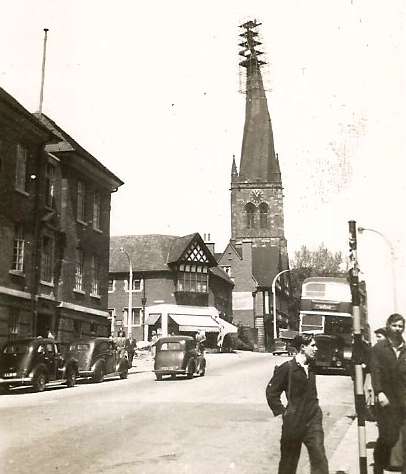
Chesterfields crooked spire with a Massey bodied Daimler passing by
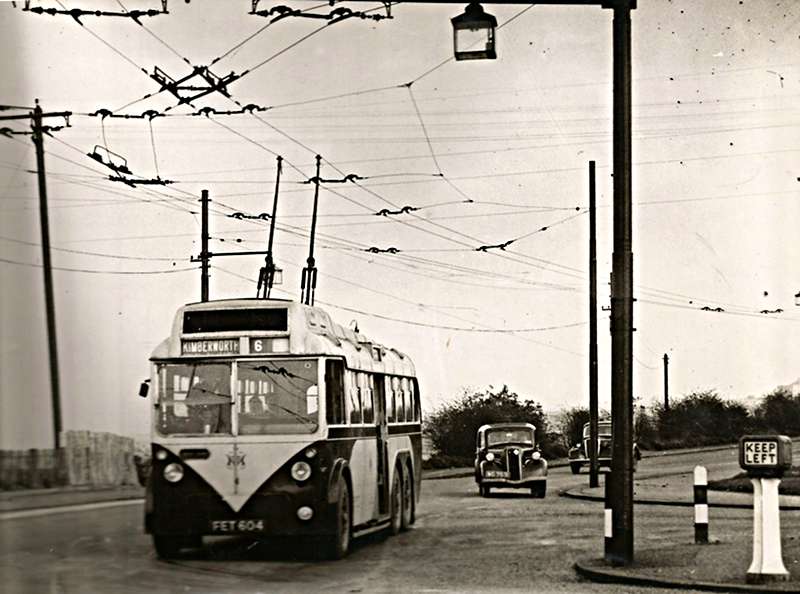
Rotherham single decker Trolleybus registration FET 604
If you would like to add any information to the above please click here
04/03/14 - 06:59
I believe Rotherham 4 (FET 604) is at the junction of Doncaster Road and Herringthorpe Valley Road, near the Pumping Station terminus, and will be working from Thrybergh. The photograph can be dated within quite a narrow window as for some reason 4, new in 1950, was one of several withdrawn as early as 1954, presumably following the closure of the Maltby route. It was not one of those rebodied as double-deckers.
David Beilby
30/07/14 - 06:43
There is a video here of Beverley including pictures of those specially built North Bar double deckers.
Presented by Peter Shipp.
Presumably the bus in the photo was one of his.
www.bbc.co.uk/videonation/features/turn_back_time/bus_to_beverley/index.shtml
John Lomas
30/07/14 - 06:45
The above link only plays if you are in the UK, still thats the BBC for you. Which bit of 'WORLD WIDE web' don't they understand.
Peter
30/07/14 - 10:02
What a superb little video about Beverley and EYMS - it brings back so many childhood and teenage memories for me as a frequent rider with the Company, and one of their most dedicated enthusiasts. The scenes are presented in the charming and informed manner that characterise Mr. Shipp who is a true and knowledgable bus proprietor of "the old school." The thought of an army of clerks totting up all the "Willebrew" clippings, plus one penny, gives a whole new meaning to the term "labour intensive" and is a job that I don't think I could have tolerated for very long !!
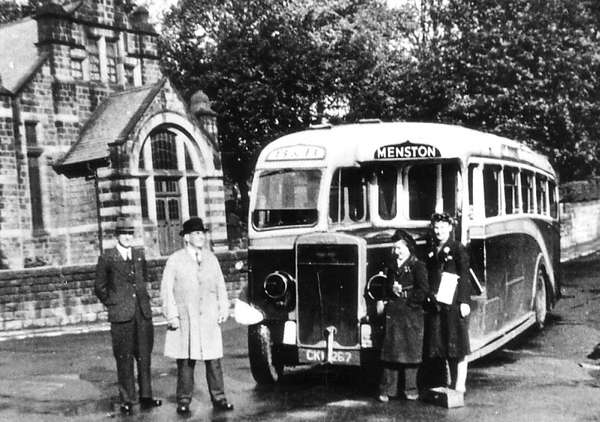
Picture attached of a wartime publicity image, source unknown, showing Samuel Ledgard TS8/Duple in Menston Village - destination falsely "imposed." The vehicle is in B & B Tours livery (a subsidiary) and notable are the headlamp masks AND The "Willebrew" ticket machine worn by the taller conductress - the large size of the machine is apparent here.
Chris Youhill
30/07/14 - 13:41
Willebrew ticket machines unique to East Yorkshire? Mr Shipp's joking! Their use was widespread.
As to whether the bus was one of 'his', I suppose it depends what is meant by 'his' - it is actually from the EYMS 'heritage' fleet. (Peter Shipp is currently Chairman and Chief Executive of EYMS. And sole shareholder!). www.eyms.co.uk/enthusiasts/vehicle?
31/07/14 - 06:24
I share your enthusiasm for East Yorkshire Chris, and still hold it in high regard, even though the buses have been the 'wrong' colour since the 1970s! It fascinates me that there was not a metal-edged kerb in sight to guide vehicles through the North Bar. EYMS drivers took their double-deckers through relying on their own skill and judgement. ("Just another tight gap flower" you could almost hear them say). It must have been a little intimidating negotiating the arch at night during the wartime blackout though.
Brendan Smith
31/07/14 - 18:07
Too true Brendan and I hadn't thought about the added difficulty of the blackout in the War or indeed the lack of effective "centralising" kerbs. The worst tight spot in my career was undoubtedly when being put on a Sunday evening excursion for Wallace Arnold with one of the huge new 36 foot Leopard/Plaxtons - to Burnsall !! Having been a conductor on WYRCC's 75 service from Ilkley to Grassington, when I used to breathe in anxiously on the drivers' behalves, I was filled with trepidation as we approached the notorious Bolton Abbey archway, and road was as always densely occupied by "weekend" drivers with little or no idea of anticipation or judgement. I felt obliged to close all the roof vents and pull in both mirrors and "breathe in" on my own account this time. Somehow we got through but there can have been very little room for error. I clearly remember one dear timid little old lady confiding "Ee luv, I hope we don't come back this way." In turn I confided in her that I shared her wish but that we were obliged to and had no option - after all the work ticket, compiled in the safety of an office, rules OK !!
Chris Youhill
01/08/14 - 06:59
Can anyone fill us in a bit more about that Rotherham single deck Trolleybus. I vaguely remember these, I think... Quite strikingly different.
The odd story seems to be that the Corporation bought 40 single deck trolleys (Daimlers?) after the war to replace an old fleet. Presumably a few were necessary to run to Mexborough- but 40? After a very short time they rebodied some and scrapped others... why? Or rather, why scrap any? Bradford & Doncaster were presumably still in the market. What has the closure of the Maltby route got to do with it? Where were the (very) low bridges?
Mysteries.... and why did Doncaster sell two new 8ft buses- was it really that they wouldn't fit the washer? Or Leeds and Ledgards? What went on in those smoke-filled rooms?
Joe
01/08/14 - 08:41
Sorry Joe, but I can't help in any way with the Rotherham query, but what exactly do you mean by "Leeds or Ledgards"?? - I may be able to help with whatever is puzzling you there.
Chris Youhill
01/08/14 - 11:25
Is my memory playing tricks, Chris, or did Leeds sell Ledgards some buses which then plied similar routes to the chagrin of local councillors, conscious of their public support? One thing that pops up here regularly is un(properly)explained disposals: what was the influence (if any) of the unions or the councillors or was it the desire of Managers to have their perfect fleet (rather than someone else's)- or just a good deal on offer? I was never an insider so it is all shrouded in mystery.
Joe
02/08/14 - 06:23
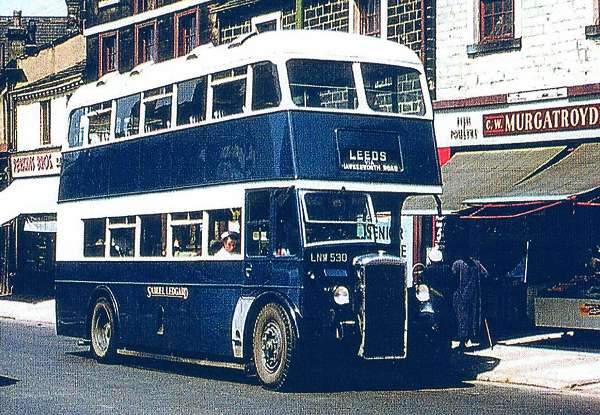
Oh that's quite easy to explain Joe. The ten vehicles to which you refer were numbers 522 - 531 (LNW 522 - 531) Daimler CVD6s of 1948 with superb quality Brush bodywork. They were buses with spring operated pre-selector gearboxes and fluid flywheel transmission and were of a type, along with many other LCT buses of similar mechanical specification, which the Corporation were removing from the fleet - in fact most had already gone by the time these ten were sold in 1960. There was nothing wrong with them except perhaps a little heavy on fuel due to the substantial Brush bodies. All were allocated to Ledgard's main depot at Armley where they served extremely well and once they were opened up to run on generous amounts of fuel (Ledgard's preferred wise and successful policy for all vehicles) they were potent and comfortable machines with top quality blue leather seating. They were seen of course regularly on the services to Bradford via Pudsey, and to Horsforth via Hawksworth Road, and to Ilkley via Otley or via Guiseley., etc etc. There was indeed a rumpus in the Council chamber about their use on similar routes and an embargo was placed on the sale of LCT buses for further PSV use in the area.
Picture here of one of the buses doing just that.
Chris Youhill
03/08/14 - 07:47
Many thanks Chris, for that beautiful photo: a Yorkshire scene with an immaculate bus with polished radiator and even a reflection in the paintwork. I know we have touched on this before, but not the photo I think, or the detail: not as bad as I thought in terms of time, but touches on one of my categories: they did not fit into the "perfect fleet" of (?) underpowered Regents! The destination box leaves no doubt with the voters as to provenance.
Joe
03/08/14 - 07:47
What a handsome looking vehicle, looking brand new and aided by the absence of adverts and Ledgard's wonderful livery. Were the blue seats a legacy or re-covered by SL, Chris?
In many respects, the body reminds me of Maidstone Corporation's 1949 Daimler CVG6/Brush vehicles, three of which were lent to London Transport on delivery to ease LT's desperate shortage. They were allocated to my local Sutton Garage to join the 100 relaxed austerity Daimler CWA6's allocated there. LT, understandably, never put adverts on them.
Chris Hebbron
03/08/14 - 07:48
I'm surprised at Chris Y regularly waxing lyrical about the ex-Leeds Daimlers of Ledgards - Mike Lockyer, in his book 'The Ledgard Fleet', reckoned they were the most unreliable vehicles Ledgard had, and it's my recollection that they were generally outlived at Ledgards by the slightly older Leyland PD1s.
David Call
03/08/14 - 12:07
Joe - As I said above, I think that vehicles with spring operated preselector transmission were removed from the Leeds fleet altogether as they were "of a different age" and amongst other things had the awful habit of injuring drivers' ankles if not perfectly adjusted and properly driven. Any underpowering of Regents was sadly caused by the LCT "cutting down" policy - both sizes of Regent engines performed perfectly well in countless other fleets, and chassis makes. The LCT Daimlers when acquired by Ledgard retained the single line destination displays over the platforms, and special comprehensive rolls were printed for them.
Chris H - the seats were not a legacy Chris but were of such high quality that they were "like new" even at twelve years old and onwards. Very similar seats were in the same splendid condition in the ex Rochdale Regents GDK 401 - 5.
David - I am always reluctant and respectful in commenting adversely on the views of those sadly departed, but I have to say that the late Mike was prone to making sensational and not always factual statements. The ex LCT Daimlers, and others bought new and "used" by Ledgards, were most certainly never unreliable and all performed very well indeed with no habitual disabilities. As to the Leyland PD1s, again new or "previously owned", well their reliability and remarkable performance even in their dotage was most creditable and enjoyable to experience, and was a true credit to Leyland Motors.
Chris Youhill
04/08/14 - 05:37
A fair defence, Chris Y. One thing that Mike did say was that he doubted that all ten ex-Leeds Daimlers were in use at the same time, but I suspect you could pick out ten vehicles at random from any fleet and stand only a limited chance of them all being available for service.
The said Daimlers, although new in 1948 and been acquired by Ledgards in 1960, lasted only until 1963-5, which seems a poor record compared with the likes of the PD1s. However it may well be that their limited life was a consequence of not unreliability or excessive fuel consumption but rather rotting of the body framework, something which Brush bodies of the period were renowned for.
It is tempting to draw a parallel with the case of the ten Bradford Brush-bodied Daimlers, which all went on to further service with Green Bus. The latter obviously thought it was on to a good thing, since it kept going back to the dealer for more until it had the entire batch, but in the example of Green Bus, as with Ledgards, the vehicles ultimately had an unimpressive lifespan, all having gone by about 1965.
David Call
Comments regarding the above are more than welcome please get in touch via the 'Contact Page' or by email at obp-admin@nwframpton.com
If you have any bus related photographs that you would like to appear in a gallery on this website please send them to me by email at obp-admin@nwframpton.com
Quick links to - Galleries - Comments - Contact - Home
All rights to the design and layout of this website are reserved
Old Bus Photos from Saturday 25th April 2009 to Wednesday 3rd January 2024